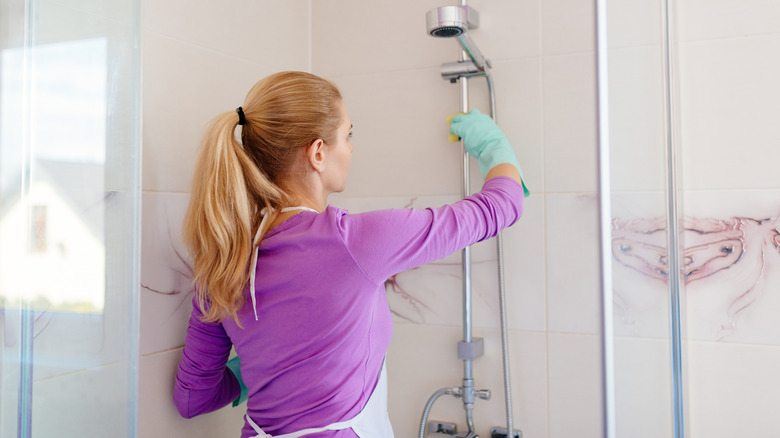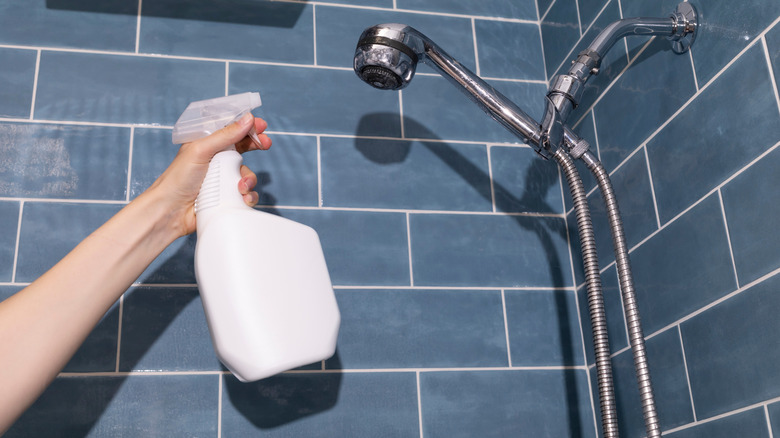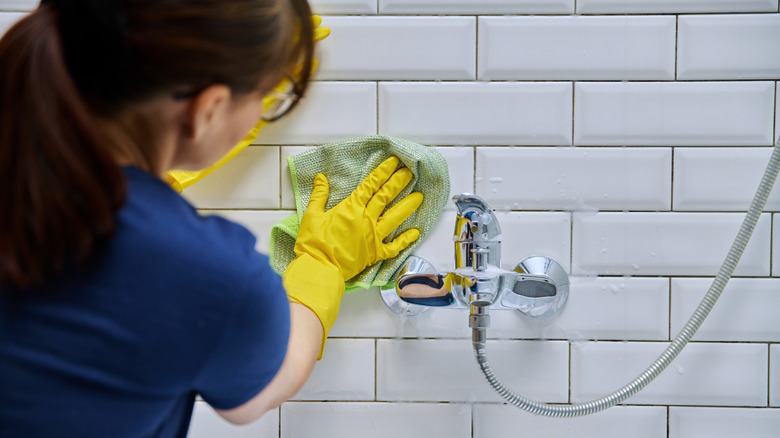The Affordable (And Natural) Way To Clean Your Shower That's Hiding In Your Medicine Cabinet
When it comes to home cleaning, many homeowners are choosing a more affordable, natural alternative to expensive and harsh chemical cleaners. Some may think that the shower is a place too tough for a natural cleaner to touch, but if you look inside your medicine cabinet, you'll find hydrogen peroxide, a powerful solution for tackling grime, mold, and mildew.
How does this seemingly boring bathroom staple pack such a big punch in the shower? It all comes back to chemistry class — and you don't have to be a genius to understand its power. Hydrogen peroxide's chemical formula is H₂O₂, meaning it's essentially water (H₂O) with an extra oxygen atom. While that extra atom might not sound super powerful, it's what makes hydrogen peroxide an oxidizing agent, capable of killing bacteria, viruses, and mildew. What's even better is that as it breaks down, it turns into simple water and oxygen, meaning it's a much safer (and environmentally-friendly) option than other harsh cleaners. While you can buy a bottle of shower cleaner from the store for around $4, hydrogen peroxide is a much more wallet-friendly option, costing only $1. Not only that, but there are many stubborn household stains you can get rid of with hydrogen peroxide, like sweat stains and coffee rings, making it an even better value.
How to clean your shower with hydrogen peroxide
Cleaning your shower is one significant way to use hydrogen peroxide in your bathroom, and the process is easy. First, you'll want to prepare the shower by clearing out all clutter, such as soap and shampoo bottles, and other accessories. Make sure the area has good ventilation — you can open a window and turn on your bathroom fan for this. Use the common 3% hydrogen peroxide solution and dump it into a spray bottle, but make sure that it is dark colored. Storing hydrogen peroxide correctly is important — it degrades when exposed to light, so using an opaque bottle will keep it effective for longer.
Spray the hydrogen peroxide directly onto your shower's surfaces, applying extra to areas with mold or mildew. Let sit for at least 10 minutes, but some tougher stains might require you to leave it on longer. Scrub with a sponge or soft-bristled brush, and rinse clean with warm water. As an optional step, use a towel to dry your shower to prevent water spots.
While you can use hydrogen peroxide by itself to clean, you can also boost its cleaning power. After your initial clean, mix hydrogen peroxide with baking soda to form a paste that will tackle stubborn soap scum and dingy grout. If you notice that the hydrogen peroxide alone isn't fully cleaning your shower, you can add a few drops of dish soap (use something unscented) to the spray to help the solution cling better to the walls and cut through stubborn stains.
What to consider when cleaning with hydrogen peroxide
As with any cleaning product, there are a few key considerations to know. First, there are different concentrations of hydrogen peroxide. The kind you buy from a drugstore or supermarket is 3%, and that's what's advised for household cleaning. There are higher concentrations, like 50%, that are dangerous for household use and should only be handled by professionals with appropriate safety gear. While you don't need to dress up in a full hazmat suit when using the standard 3% concentration to clean your shower, it's advisable to have proper ventilation and wear gloves and eye protection to prevent irritation.
While hydrogen peroxide and vinegar are both great cleaners separately, you should never mix them together since this can create peracetic acid, which is corrosive and harmful. You can, however, use them in succession by first cleaning with hydrogen peroxide, making sure you rinse well. Then, spray with white vinegar to tackle hard water stains and provide an extra layer of disinfection. The same goes for bleach — if you're using hydrogen peroxide to clean your shower, skip the bleach, as the two create a noxious gas.


